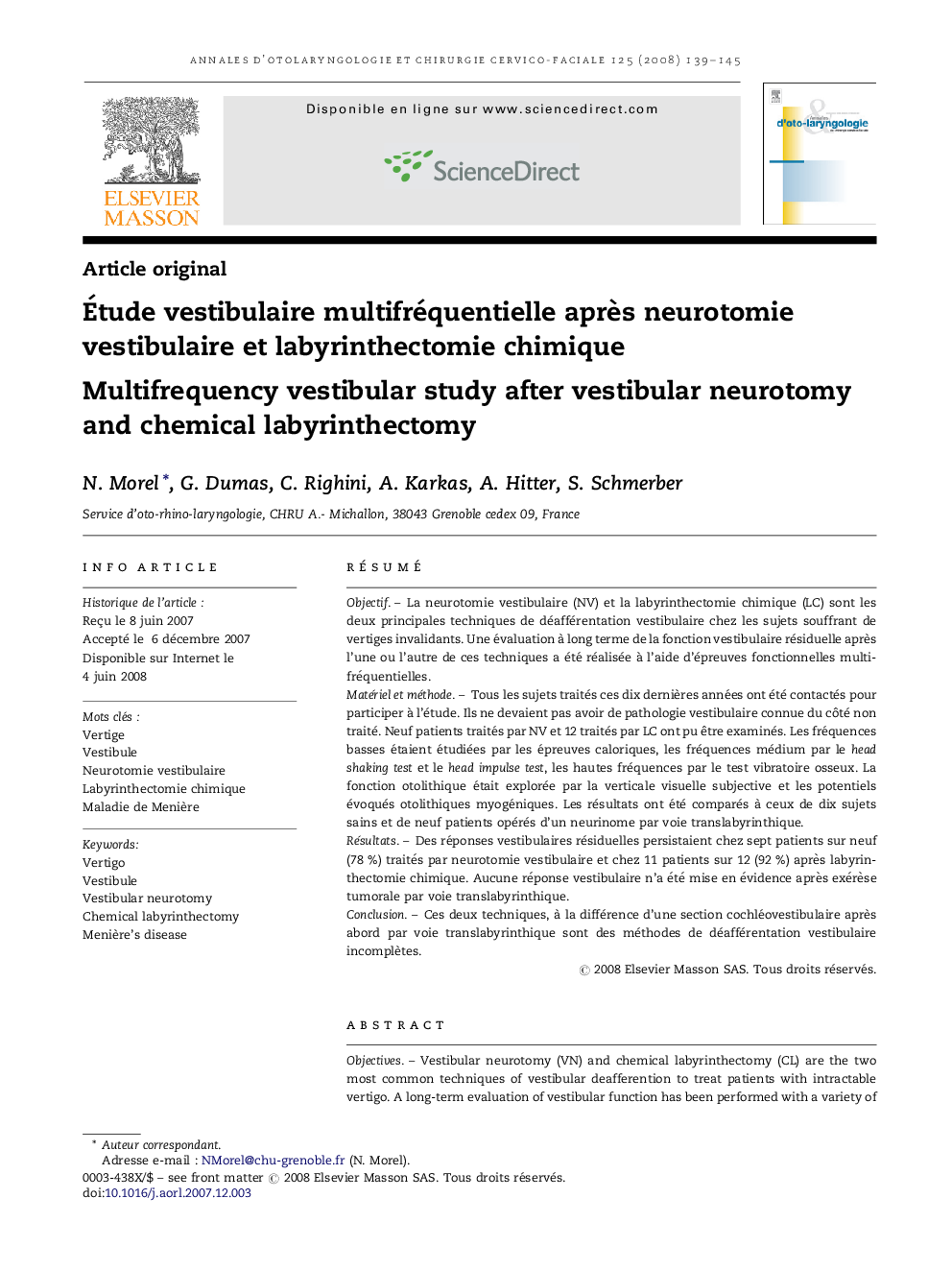| کد مقاله | کد نشریه | سال انتشار | مقاله انگلیسی | نسخه تمام متن |
|---|---|---|---|---|
| 4105865 | 1269180 | 2008 | 7 صفحه PDF | دانلود رایگان |

RésuméObjectifLa neurotomie vestibulaire (NV) et la labyrinthectomie chimique (LC) sont les deux principales techniques de déafférentation vestibulaire chez les sujets souffrant de vertiges invalidants. Une évaluation à long terme de la fonction vestibulaire résiduelle après l’une ou l’autre de ces techniques a été réalisée à l’aide d’épreuves fonctionnelles multifréquentielles.Matériel et méthodeTous les sujets traités ces dix dernières années ont été contactés pour participer à l’étude. Ils ne devaient pas avoir de pathologie vestibulaire connue du côté non traité. Neuf patients traités par NV et 12 traités par LC ont pu être examinés. Les fréquences basses étaient étudiées par les épreuves caloriques, les fréquences médium par le head shaking test et le head impulse test, les hautes fréquences par le test vibratoire osseux. La fonction otolithique était explorée par la verticale visuelle subjective et les potentiels évoqués otolithiques myogéniques. Les résultats ont été comparés à ceux de dix sujets sains et de neuf patients opérés d’un neurinome par voie translabyrinthique.RésultatsDes réponses vestibulaires résiduelles persistaient chez sept patients sur neuf (78 %) traités par neurotomie vestibulaire et chez 11 patients sur 12 (92 %) après labyrinthectomie chimique. Aucune réponse vestibulaire n’a été mise en évidence après exérèse tumorale par voie translabyrinthique.ConclusionCes deux techniques, à la différence d’une section cochléovestibulaire après abord par voie translabyrinthique sont des méthodes de déafférentation vestibulaire incomplètes.
ObjectivesVestibular neurotomy (VN) and chemical labyrinthectomy (CL) are the two most common techniques of vestibular deafferention to treat patients with intractable vertigo. A long-term evaluation of vestibular function has been performed with a variety of vestibular tests to find out whether there persisted any residual vestibular function after each technique.MethodsWe called in all patients who have been treated for the last 10 years and have no known vestibular disease in the non treated ear. Low frequencies were analyzed with caloric tests, medium frequencies with the head-shaking test and head-impulse test, and high frequencies with the skull vibration test. The otolithic function was explored with the subjective vertical visual analysis and otolithic myogenic evoked potentials. Nine patients treated with VN and 12 with CL presented to our department. We were thus able to compare VN and CL patients with a group of 10 normal patients and another group of nine patients that had had a translabyrinthine approach for an acoustic neuroma.ResultsWe found out that vestibular responses did persist in seven out of nine (78 %) patients after VN and 11 out of 12 (92 %) patients after CL. On the other hand, no vestibular response was detected following resection of vestibular schwannoma through a translabyrinthine approach.ConclusionWe came to the conclusion that the two latter techniques, unlike vestibulocochlear nerve section via the translabyrinthine approach, are only incomplete methods of vestibular deafferention.
Journal: Annales d'Otolaryngologie et de Chirurgie Cervico-faciale - Volume 125, Issue 3, June 2008, Pages 139–145